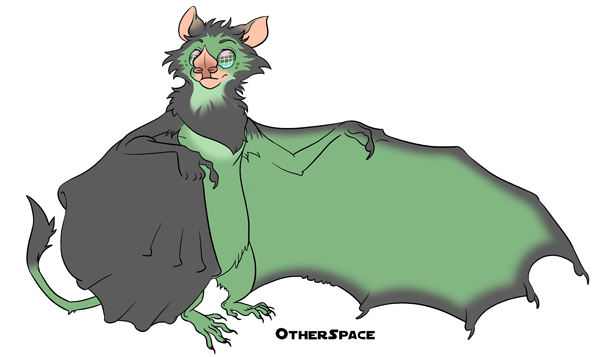m |
|||
| Line 1: | Line 1: | ||
| + | [[Category: Setting]][[Category: Races]] | ||
*'''Scientific Name:''' n/a | *'''Scientific Name:''' n/a | ||
*'''Classification:''' Bipedal Noctillionine | *'''Classification:''' Bipedal Noctillionine | ||
Revision as of 08:30, 21 January 2011
- Scientific Name: n/a
- Classification: Bipedal Noctillionine
- Average Height: 3 feet
- Average Weight: 24.5 lbs
- Average Lifespan: 90 years
- Native Language: Hekayan
- Homeworld: Kamsho
Contents
Overview
One of four intelligent races that have evolved on an ancient homeworld of the Kamir - once known as Kamm Shohob, now known as Kamsho. All four races on Kamsho are creations of the Kamir. Tupai adults average about three feet in height, bipedal with two arms with leathery skin flaps that expand to serve as wings, two squat legs, and a sinuous tail. They have blunt, pug-like snouts and shiny black compound eye clusters. Their fur ranges from dark green to gray. The Kamir created the Tupai to work as servants in their grand palaces on Kamm Shohob, Aukam, and elsewhere throughout Hiverspace. After the exodus of the Kamir, however, the Tupai were without masters. They became absorbed primarily into the cultural landscape of the Llivori, who employ them as inexpensive labor. Higher-paid Tupai are put to use as spies, often conducting aerial surveillance and other covert operations against the Opodians.
Social Standing
All Tupai work under Llivori, very often doing cheap labor, trivial tasks, or servant work. Higher paid Tupai work as spies for anti-Opodian organizations. Tupai feel that they cannot function without a task from a Llivori. Some admit that they're afraid of doing anything else. Others believe that they are doomed to fail in whatever other endeavors they may want to try, because the Llivori are much more intelligent and pressumed to know best ways through life. Very rarely are there exceptions to this train of thought for Tupai.
Behavior
Like many sentient species, Tupai behavior varies from subject to subject. Personality-wise, they tend to be on the humble side, at least around their employers. Tupai have a great passion for flight, having created several airborn games involving skills in banking, diving and maneuvering. Many feel most comfortable in dark conditions. Some Tupai enjoy perching on shoulders; the farther away from the ground they are, the happier. A scratch behind the ears is considered the utmost type of praise from a Llivori. Not unlike Earthen bats, Tupai sleep hanging upside down and rarely any other way.
Tupai are capable of echolocation ie. sending high-pitched 'pings' to bounce off of unseen objects to help locate things or fly at night.
Physical
As with personality, body types vary widely, but still follow the basic structure of a fleshy, upright nose, large ears, green-gray fur, a slender tail, compound eyes and leathery wings.Wings
There are two major wing structure types: Micropointers and Drakewings. This is akin to how some humans are born double-jointed and others are not. Drakewings are the norm, and Micropointers are a little rare.
Micropointer wings have a thumb free from membrane and a very short index/pointer digit, thus the name micropointer. Their fifth digit (or pinky) points straight down when the wing is stretched. Micropointer Tupai are often swifter than Drakewing Tupai.
Drakewings have membraned thumbs with digits of equal length. The membrane is a bit more broader which makes for better maneuverability compared to Micropointers. With muscular digits, Drakewing Tupai are considered to be powerful fliers that are capable of lifting several times their own weight.
Eyes
Tupai eyes are compound and very similiar to insects. While the base color is black, they have an iridescent sheen that causes colors at different angles. Sight is divided into multiple facets, so Tupai, like insects, see many versions of the same thing.
Ears
The ears come in many different shapes though very often they're as tall as the head itself if not taller.
Noses
Tupai snouts are always pressed inward and never narrow (like a fruit bat). Like their ears, the noses (or noseleaf) are highly sensitive to not just scent but sound and vibrations.
Games
Most Tupai games are impromptu and don't require points or teams. A popular youth game is simply chasing after a player with an object, like a flag or ball. Some play catch with the wildlife, some race, some just spar in the air.
Some Tupai will compete against Falari and other flight-capable races in the aerial olympic events in the Talon region on Falar. Wind Wreath
The airborn game is point-driven and focuses on agility and speed. It's made up of two Tupai, the server and the darter. Using their mouth, feet or tails, the server tosses a hoop into the air and both them and the darter fly after it. The server must reach the hoop and catch it before the darter goes through it. If the darter passes through the hoop before the server can catch it, they are awarded 1 point. If the darter fails to go through the hoop before the server catches it, 1 point is awarded to the server. The game is over when one of them reaches 12 points.
To summarize, the server must catch the hoop before the darter can get through it. The darter must get through the hoop before the server catches it.
Naming Conventions
Male Names
- Anto
- Aron
- Dalber
- Delari
- Laric
- Lebo
- Mador
- Marant
- Navent
- Onso
- Ornal
- Togust
- Varo
- Yetan
Female Names
- Adea
- Amudena
- Dalina
- Daluea
- Esmer
- Heyinora
- Lonza
- Mygdi
- Ralia
- Riana
- Talina
- Tietta
